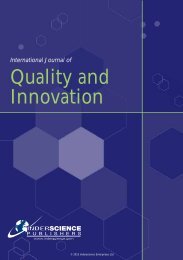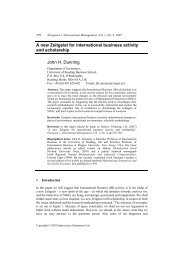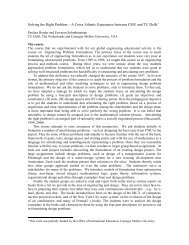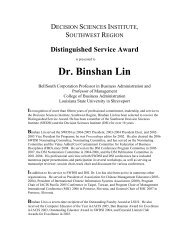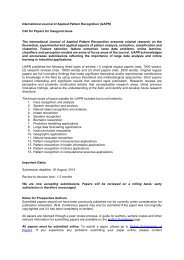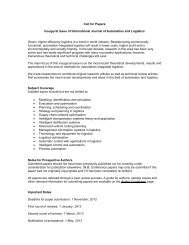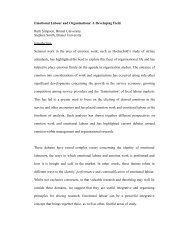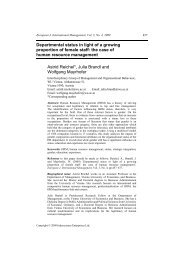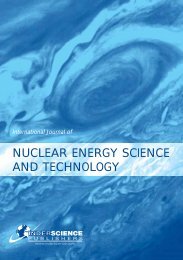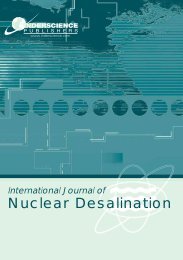Editorial: progress in Green Economics: ontology, concepts and ...
Editorial: progress in Green Economics: ontology, concepts and ...
Editorial: progress in Green Economics: ontology, concepts and ...
Create successful ePaper yourself
Turn your PDF publications into a flip-book with our unique Google optimized e-Paper software.
<strong>Editorial</strong> 241<br />
Professor Maria Mies, Cologne University, Patriarchy <strong>and</strong> accumulation on a world<br />
scale revisited<br />
We are also fortunate to have a contribution from Maria Mies, Patriarchy <strong>and</strong><br />
Accumulation on a World Scale Revisited, who was the first professor of women’s<br />
studies <strong>and</strong> br<strong>in</strong>gs a sound fem<strong>in</strong>ist as well as a develop<strong>in</strong>g country perspective,<br />
hav<strong>in</strong>g lived <strong>in</strong> India for many years. Her thesis of patriarchy <strong>and</strong> accumulation was<br />
one of the found<strong>in</strong>g build<strong>in</strong>g blocks to our th<strong>in</strong>k<strong>in</strong>g <strong>in</strong> <strong>Green</strong> <strong>Economics</strong>, although<br />
some of her ideas will be new to some readers. She is able to l<strong>in</strong>k development<br />
critique, <strong>in</strong>ternational production, patriarchal critique <strong>and</strong> women’s experience of world<br />
trade, with a rigorous economics <strong>and</strong> social theory analysis. She is also one of the<br />
few alternative writers to exhibit a proper underst<strong>and</strong><strong>in</strong>g of the structure of modern<br />
<strong>in</strong>ternational trade <strong>and</strong> to jo<strong>in</strong> up her th<strong>in</strong>k<strong>in</strong>g on fem<strong>in</strong>ism <strong>and</strong> patriarchy to these<br />
structural changes <strong>in</strong> trade. She reveals how the hidden work of women <strong>in</strong> the household,<br />
the work of subsistence producers work<strong>in</strong>g <strong>in</strong> the <strong>in</strong>formal sector <strong>and</strong> the work of<br />
nature constitute the hidden underground of the capitalist world, economy <strong>and</strong> its<br />
accumulation model.<br />
Dr. Hazel Henderson, USA, 21st century strategies for susta<strong>in</strong>ability<br />
Henderson provides a more spiritual <strong>and</strong> physical account of the economy. She discusses<br />
how current economic models drive today’s unsusta<strong>in</strong>able forms of globalisation, which<br />
is consum<strong>in</strong>g 40% of all photosynthetic production, <strong>and</strong> is lead<strong>in</strong>g to the current mass<br />
ext<strong>in</strong>ction of other species. She proposes that technological <strong>in</strong>novation is needed to shift<br />
from fossil fuels to renewable energy, recycl<strong>in</strong>g <strong>and</strong> redesign <strong>in</strong>dustrial processes. She<br />
shows how fundamental research on the human bra<strong>in</strong> now refutes most of economics<br />
core tenets.<br />
Professor David Simon, Urbanisation <strong>and</strong> global environmental change:<br />
new <strong>in</strong>tergenerational challenges<br />
Simon provides a much needed physical reality check to the background of our lives,<br />
our economics <strong>and</strong> our social science discussions. We will all be affected by<br />
global environmental change <strong>and</strong> we all need to consider its physical manifestations<br />
<strong>and</strong> their implications. Professor Simon expla<strong>in</strong>s the ma<strong>in</strong> mechanisms of Global<br />
Environmental Change <strong>and</strong> builds on the f<strong>in</strong>d<strong>in</strong>gs of the Stern (2006) report <strong>in</strong>to climate<br />
change <strong>and</strong> the 4th Assessment of Report of the Pachauri (2007). His paper outl<strong>in</strong>es<br />
the bi-directional relationships between GEC <strong>and</strong> urbanisation <strong>and</strong> highlight<strong>in</strong>g<br />
<strong>in</strong>tergenerational equity issues that arise. He expla<strong>in</strong>s the ‘green’ <strong>in</strong> <strong>Green</strong> <strong>Economics</strong>,<br />
<strong>and</strong> rem<strong>in</strong>ds us how it is vitally important to remember there is much science with<strong>in</strong><br />
<strong>Green</strong> <strong>Economics</strong>. It is an economics which can deal with climate change as it is part<br />
natural science <strong>and</strong> part social science. His article serves to focus economists <strong>and</strong> social<br />
scientists m<strong>in</strong>ds on the physical impacts of the most recent of the last 10 000 years of<br />
civilisation, <strong>in</strong>clud<strong>in</strong>g the construction of vulnerable mega-cities built on <strong>in</strong>secure natural<br />
resource foundations.



